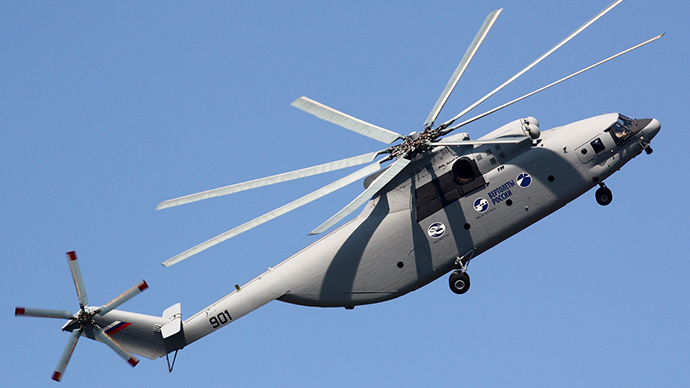Russia launches production of upgraded Mi-26, world’s largest helicopter

The world’s most powerful heavy transport helicopter, the Mi-26T2, is now officially on the production line, Russian Helicopters Corp announced.
“We announce the start-up of production of the modernized
heavy helicopter Mi-26T2 serial production. Helicopters of Mi-26
family have unequalled characteristics, and their modernization
considerably expands the potential of this aircraft,” said
Russian Helicopters CEO Andrey Shibitov.
Creating heavy duty helicopters is a particularly challenging
task for aircraft designers, but Russia has “colossal and
unique experience” in this field, Shibitov said.
Russian Helicopters launches series production of the new heavy Mi-26T2 #helicopter / http://t.co/Ev49cQagYqpic.twitter.com/I7hI6BN2Ll
— Russian Helicopters (@RusHeliCo) May 22, 2015
There is no doubt the Mi-26T2 is going to be in demand in Russia
and abroad, he added.
The Soviet-Russian heavy transport helicopter Mi-26 (NATO
designation: Halo) remains world's largest and most powerful
helicopter to ever go into serial production. The aircraft has
both civilian and military modifications. Starting from 1980,
there were 316 machines produced.
Mi-26T2 has a maximum takeoff mass of 56 tons and 800 kilometer
one-filling fuel capacity; its top speed is 295 km/h, while its
fuel-efficient version has a top speed of 255 km/h.
The Mi-26T2’s payload capability is 20 tons, whereas its nearest
rival, the American Sikorsky CH-53E, has an external load
capability of 16 tons. It has been rumored that further Mi-26T2
modernization might increase helicopter’s payload capability to
25 tons.
The helicopter passed all basic tests in 2010-11. The Mi-26T2 was first presented to the public at the MAKS-2011 air show.
PHOTO: Algerian Mi-26T2 #903 seen during a test flight at Rostvertol Plant in Rostov-na-Donu on April 9 ©Ми-26 pic.twitter.com/28BdukkQvK
— Missilito (@Missilito) April 10, 2015
Mi-26T2 helicopters are assembled at the Rosvertol factory in the southern Russian city of Rostov-on-Don.
The Mi-26T2 has improved avionics and modern navigation controls with five displays. This has allowed the designers to reduce the crew from five to three pilots, though just two are enough to operate the machine itself.
El impresionante Mi-26T2, conocido por ser el helicóptero más grande del mundo: http://t.co/yQSaqEMQGLpic.twitter.com/fDrmMpueQx
— Eugenio Rodríguez (@eugeniorguez) January 20, 2015
Unlike its predecessor, the Mi-26T2 is 24-hours-a-day operable
and has special night flight equipment.
In early 2015, two Mi-26T2 helicopters were assembled for export
and after tests will be delivered to Algeria.











